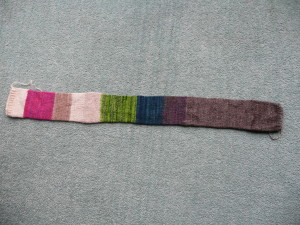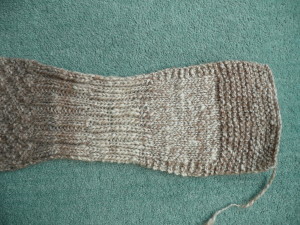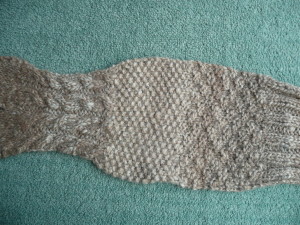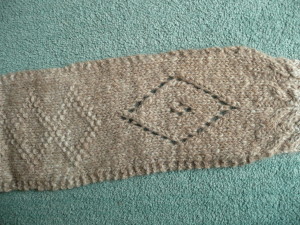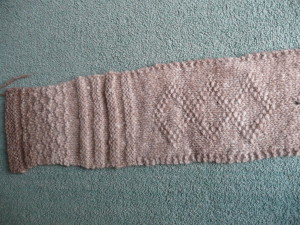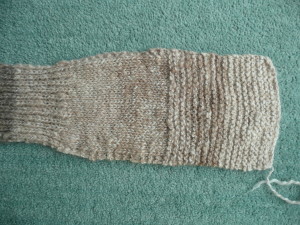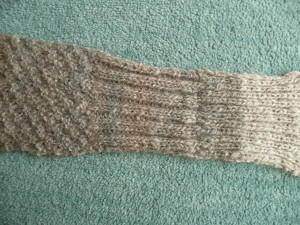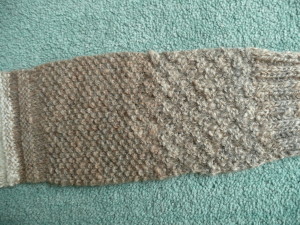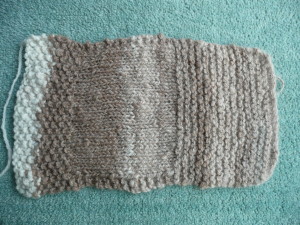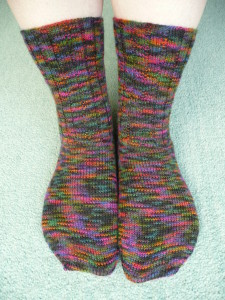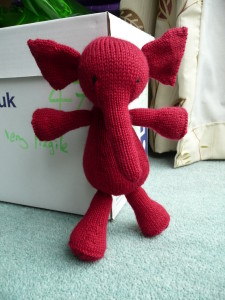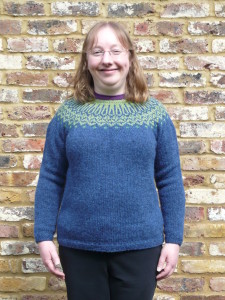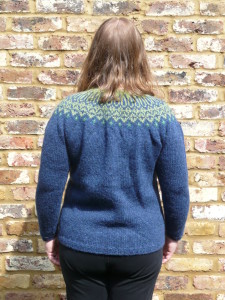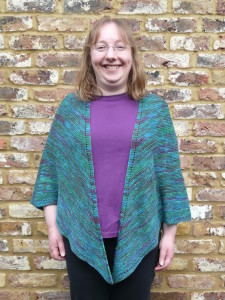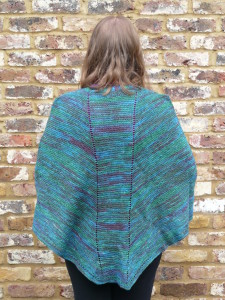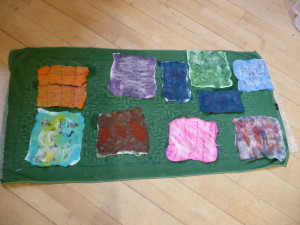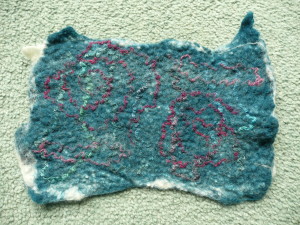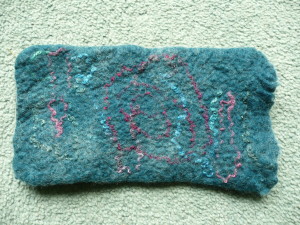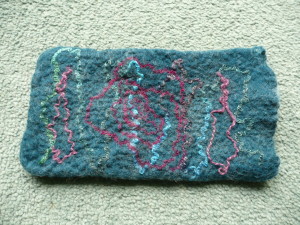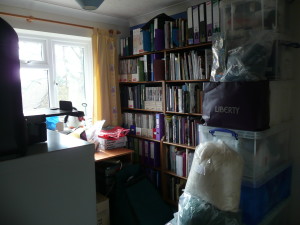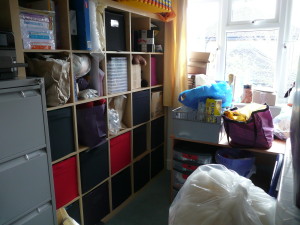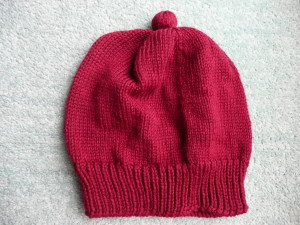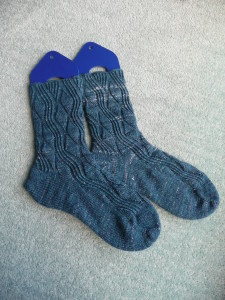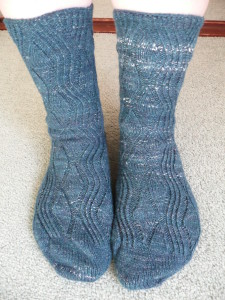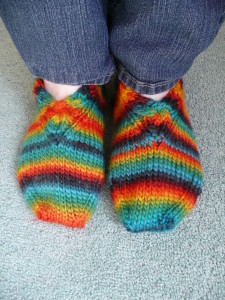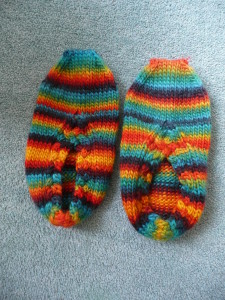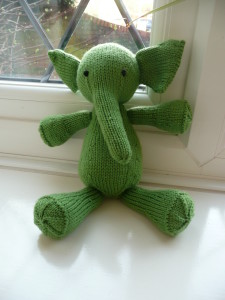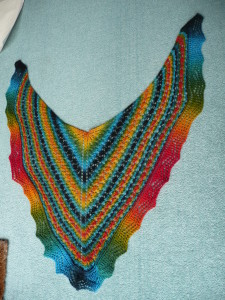Back in October last year I went to a Wingham Woolwork sampling day organised by the Hampshire Guild of Spinners, Weavers, and Dyers. This was the second time I had been to a sampling day – the first was organised by the Kennet Valley Guild, so at least this time I knew a little of what to expect.
The idea is that you bring along your spinning wheel, or spindle and your lunch (or you can buy lunch there), you pay your entrance fee and then can have a go at spinning whichever fibres you fancy. It is a great way of trying out new things without committing yourself to an entire projects-worth.
Last time I mostly concentrated on the different merino colour blends – something I am still fascinated by, but this time although I spun a couple of colour blends I mostly experimented with different fibre mixtures. It was great fun, and although they were only small amounts I have a little bit more of an idea of what different fibres are like to spin with and knit.
I spun them up all one after another and then chain-plied them to create a 3-ply. My knitted sample has a little bit of 1×1 rib at each end to stop it curling but is otherwise stocking stitch – all on 2.5mm needles.
Starting from the bottom (the right of the picture) the fibres are:
1) 50% brown yak, 50% silk
2) 70% brown Bluefaced Leicester, 30% silk
3) 70% merino, 30% silk
4) 70% merino, 30% silk
5) 100% merino
6) 50% cashmere, 50% silk
7) 100% tussah silk
8) Baby camel and merino, not sure of proportions
9) 100% merino
10) 50% white yak, 50% silk
The yak and silk mixture is lovely, and manages to be both drapey and fluffy whilst also being incredibly soft. I was surprised at how coarse the BFL and silk is, perhaps the BFL used in this particular blend was not a very soft example? The cashmere and silk was easier to spin than I feared, though not as relaxing a spin as other fibres, it seems to have spun up thicker than the other blends. The silk is lovely and drapey and shiney and crunchy. I think I would like to experiment with spinning more and knitting a larger piece to see if I had problems with it not holding its shape. The baby camel and merino was surprisingly lovely to spin, and is soft and warm.
It was good fun to see what some different fibres are like, and I was pleasantly surprised that they weren’t as difficult to spin as I had feared. I think in these cases the blends can help make a short fibre easier to spin by mixing it with a longer one.
Back in the summer last year I had a go at doing longdraw spinning (with varying degrees of success!). My yarn was rather lumpy, but I thought I would ply it up in three different ways and then knit with the results and see how they came out. My largest sample was a 3ply, made from three separate singles. This had the advantage of evening out the worst of the lumpy bits and was the most successful of the finished yarns. I tried knitting several different stitches to see how they would each fare.
I used 6mm needles for this sample. I thought the garter stitch, moss stitch, and particularly the welting pattern were most successful, with the stocking stitch and 1×1 rib unfortunately exacerbating the lumpiness (the 2×2 rib wasn’t so bad), and the cables and lace just getting a bit lost in all the fluffiness.
My next sample was a 2ply, for this one I used 5mm needles.
This yarn was less round and had more texture than the 3ply. Again it looked best in garter stitch, moss stitch, double moss stitch, and welting. Both the stocking stitch and the 1×1 and 2×2 ribs showed up how uneven the underlying yarn was.
My last and smallest sample was a chain ply. Due to the construction this method of plying magnified the unevenness in the original single and was the least even of all the finished yarn.
I used 5.5mm needles for this one. The garter stitch and particularly the moss stitch are pleasingly rustic, whereas the stocking stitch just looks uneven.
This whole experiment has been very interesting, both from the spinning and the knitting perspective. Also I think that my findings can equally be applied to uneven and textured commercial yarn. I think I would definitely avoid stocking stitch and ribs (particularly 1×1 rib) in a textured yarn – they run the risk of just looking messy. Garter stitch, variants of moss stitch, and welting seem to work well with texture. Cables and lace can run the risk of just getting lost in a fluffy yarn – probably best to do a test swatch since it will depend on the individual yarn and pattern combination.
Now onto a couple of finished projects:
First some very loud socks 🙂
The yarn is Zitron Trekking XXL and came from Mummy and Daddy from one of their holidays. I used 2.25mm needles. I made the pattern up, it is a very basic rib leg and stocking stitch foot pattern, with a garter stitch short row heel. I wanted a simple pattern since the yarn is so exciting it would obscure anything with more detail.
Next is another elephant, for a baby due this summer.
This one is made from King Cole Merino Blend DK, and I used 3mm needles. The pattern is Elijah.
My most recent finished project is a jumper made out of Lett Lopi. The pattern is from a Craftsy class that I have been enjoying (Top Down Icelandic Sweater). I had been hoping to buy the yarn from Alafoss at Unravel in February. However they were so successful that by the time I got to their stand half way through Saturday they had completely sold out! I did manage to get a shade card though, and so could decide about the colours in the comfort of my own home and order online.
I tinkered with the pattern a little to make it a jumper rather than a cardigan, and to make it a bit more fitted. I used some ideas from Amy Herzog’s Knit to Flatter book, and so went for zero ease at the chest and hip, and 3 inches of ease at the waist, with the waist shaping only done on the back of the garment. It came out a little more fitted than planned(!) due to my tension changing a little from the swatch to the finished garment, but I think it is still wearable.
I find the Lopi to be on the edge of what I find a little too scratchy. I have quite sensitive skin and have been experimenting with which fibres I find comfortable. For many years I thought I couldn’t wear wool at all, but fortunately it turns out I can wear quite a lot of wool, depending on the breed, and on whether it is touching a particularly tricky bit of skin. I shall be interested to wear this jumper for a bit and see what I reckon to it. I have a hat made from Lopi which I find ok, but that isn’t in contact with the inside of my elbows!
My final finished project of the catch up (and I am now finally up to date! hooray!) has been a long time coming. I checked on my ravelry project for this and I have been knitting it over a year! Well actually I have knitted it about two and a half times, due to a mess up with my calculations for the shoulder shaping, then undoing the edging so that I could maximise the yarn used.
The pattern is Fenna by Myrna Stahman, the yarn is some 50% merino, 50% tencel that I dyed a few years ago, and I used 4mm needles. I decided to go for a very simple garter stitch pattern to make the most of the coloured yarn. It is very comfy, and the shoulder shaping (now I have got it right!) really does mean that the shawl stays on as you move around.
At the beginning of April the West Surrey Guild of Spinning, Weaving, and Dyeing held a felting workshop with Janine Rees. This was the first time I had had a go at felting but luckily Janine made the workshop suitable for complete beginners as well as those with a bit more experience. Janine started the workshop by showing us a variety of felted pieces she has produced, and explaining about how felt is created. She then demonstrated how to make a piece of flat felt, and we all had a go.
Here are our examples of flat felt:
And my sample. We used merino wool for the main felt and then decorated it with a variety of bits of yarn.
At lunch time we were able to look at several books on different aspects of felt making that Janine had brought with her, and also to have another closer look at her felted pieces.
After lunch we moved on to making 3D felt around a resist made of thin foam. I made a little pouch.
In my excitement to get felting I forgot to add a thin layer of merino fibres over the top of my decoration on the second side. Interestingly the handspun merino yarn, and the 50% merino, 50% tencel yarn adhered to the surface with no problems anyway. The handspun Southdown yarn though has stuck in some places and not in others. Empirical evidence that not all wools felt the same!
It was a fun day and I look forward to having a go at more felting soon.
And finally a couple of photos of my lovely new craft room.
As you can see I have quite a lot of tidying to do!
